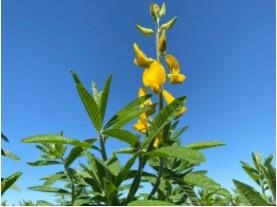By Susan V. Fisk
If you’ve ever moved from one location in the US to another, you may know that different regions have different “hardiness zones” for outdoor plants. So, if you live in the south, and want to bring a prized rose bush when you move to a northern state, it most likely won’t survive.
Growers face the same issues. Where a crop is tolerant to conditions in one state, it may not work in another. The same could be true in different regions of states – the western coast of Washington gets more rainfall than the eastern part. That means growers may have to plant and harvest different crops, even in the same state.

Research shows that sunn hemp can be grown in eastern Wyoming. Like other types of forage crops, it can be baled and used for animal feed.
The Northern High Plains of Wyoming have a crop and livestock industry that is limited by market accessibility, infertile soils, and short growing seasons. Adding a new type of crop that farmer's could grow could help maintain the sustainability of the area. A research team at the University of Wyoming is researching whether sunn hemp, a typically southern crop, can be grown in Wyoming.
“Developing alternative crops that not only maximize productivity but also meet a multitude of needs for producers is vital in the region,” says Carrie Eberle, an assistant professor at the university. “Producers in Wyoming have identified improved forage, drought resistant forage, and alternative legumes and forages as research priorities for production agriculture research. Sunn hemp is a legume crop and could meet all those needs.”

Sunn hemp is part of the family of legumes. These plants work with soil microbes to pull nitrogen gas from the air and form compounds the plant can use as a food source.
The results of Eberle’s research were recently published in Crop Science Journal, a publication of Crop Science Society of America.
Sunn hemp is a fast-growing crop, often producing over two tons of biomass in just 60 days. All the leaves and stems create biomass. When cut and left on the field, it can be used as a “green manure.” In other areas, it is grown as a forage for animals. Sunn hemp is adaptable to a wide range of soil types and is relatively drought resistant, good news for semi-arid and drought-prone areas like eastern Wyoming. And, as a legume crop, it can add nitrogen to the soil through a process called nitrogen fixation.
Just over half of the forage fields in Wyoming are planted with alfalfa, another legume. Other common warm season annuals used as alternative hay sources are teff grass, millet, and sorghum. However, these crops don’t have as much nutrition for animals as alfalfa – or sunn hemp.
Click here to see more...